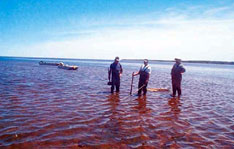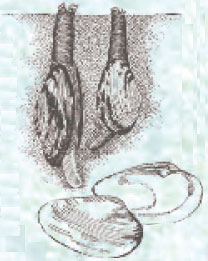page5
Local residents, Aboriginal communities and fishers work together to restore Soft-shelled clams
Restoration and maintenance of valuable resource requires input from all stakeholders
Harvesting Soft-shelled clams (Mya arenaria) has always been a part of life for local people in Kent County in eastern New Brunswick. This invertebrate symbolizes the profound link the people of the area—especially First Nations communities—have with the land and what is now the coastal area of Kouchibouguac National Park of Canada. Soft-shelled clam harvesting is recognized as a traditional fishery activity in the park by the federal government. Parks Canada understands that the long-term restoration and conservation of the species depends on strong support from local residents and users of this important resource.
Since 1981, the local population has been allowed to practice traditional activities such as commercial fishing and soft-shelled clam harvesting in park territory. However, no effective management system was in place to ensure the long-term viability of the clam population under harvesting pressure. By the late 1990s, data collected by park ecologists on soft-shelled clam stocks over the past 25 years demonstrated that clams in all age classes were being over-harvested.
In response to the data, Parks Canada developed a Soft-shelled Clam Management Plan for the park in 1999. Two years later, a joint management committee was struck, which brought local commercial fishers into the management decision-making process. The commercial clam fishers, park conservation staff, Maritime Fishermen's Union and First Nations agreed to close the clam beds in 2001 to allow the clam population to recover.
 Group of fishermen in the water © Parks Canada / Don Pentz |
The goal of the management plan is to restore the clam population within the park to a viable level by working closely with local communities, commercial and recreational fishers and the First Nations communities surrounding the park. In 2001, the Kouchibouguac Commercial Clam Fishermen Association was established. The association's 11 members work in the field with park staff on several aspects of clam management, such as the Clam Guardian Program, population inventories and active restoration techniques. The association's in-kind support is a major contributor to the success of the management plan. Now, even more participants have been invited into the management process, including watershed groups, other fishers' associations, surrounding communities and First Nations representatives.
The overall project will see 11 commercial fishers and one Aboriginal technician trained in scientific methods relating to conducting restoration work and inventories of clam beds and spat (young clams). These participants will be able to share their expertise and train other groups in research techniques and resource management practices. A "Clam Management Handbook" is being developed so that all groups use standardized methods to carry out clam inventory and management practices.
 Detailed drawing of a clam © Parks Canada / L. Bjornson |
Another important component of this project is the scientific evaluation of clam spat fall collection techniques, more commonly called "clam tents." These techniques use a variety of steel structures covered with fine netting to promote breeding. After spawning, the clam larvae attach themselves to the structure and colonize the bottom of the estuary.
Clam tents had never been used in Atlantic Canada until the summer of 2003, when the Kouchibouguac Commercial Clam Fishermen Association suggested that the technique be tested in the park's lagoon. Because no harvesting had taken place that year, it was an excellent occasion to scientifically evaluate the efficiency of the technique. With funding from the New Brunswick Department of Agriculture, Fisheries and Aquaculture, a preliminary trial was undertaken in the park by Parks Canada staff, scientists from the Université de Moncton, commercial fishers and the federal Department of Fisheries and Oceans. Preliminary results indicate that this technique could work in a coastal sandy environment.
Stakeholders and committed partners are looking to Kouchibouguac National Park of Canada to provide leadership and technical expertise in communicating continued restoration techniques and best practices relating to Soft-shelled clam research, management and restoration. Already, several other groups have approached park staff to conduct inventories and restoration work in the Richibucto estuary, using the knowledge gained at Kouchibouguac through the collaborative clam management program.
By "exporting" proven technologies to Aboriginal fishers and other fishers outside the park, Parks Canada is supporting and engaging these groups in the active restoration of their clam beds. Once the clam beds outside the park are restored, the harvesting pressure on the park-based clam stocks will be greatly reduced.
Results
- Data on clam beds are analyzed and mapped with a Geographic Information System (GIS), allowing representation of each clam size class and of clam bed distribution. For the first time, managers have access to a spatial representation of clam beds, which is a critical management tool.
- New methods allow managers to implement rotation-type harvesting by being able to determine the beds currently ready for harvesting and predict the year that other beds could be open for harvest.
- Eleven commercial fishers and one Aboriginal technician will be trained by Parks Canada staff in scientific methods relating to conducting inventories of clam beds and clam spat.
- Date modified :